a few weeks ago, Jill and i took a whirlwind trip along the Southern coast of Japan's main Honshu Island to see the famous town of Hiroshima. while details of that trip will follow in another post, here i'll explain one thing that made it so whirlwind. we finally got to do something i've been wanting to since we got here, to take a ride on a true Japanese institution: the Shinkansen (新幹線). better known to us in the West as a bullet train, Japan is famed for having introduced them in 1964, and is making headlines once again with their new speed record-breaking maglev trains.

as the wikipedia article makes clear, there are several different kinds of trains referred to as shinkansen. i think the 300 series looks the best, and fortunately for me it was the kind we first rode.
literally meaning "new trunk line", shinkansen has brought all of Japan within reach of a very train-oriented people. physical reach, at least, if not economic, because you practically have to sell your soul to get on the thing. not that plenty of people in wealthy Nagoya aren't prepared to do that; the 16-car long things are zooming off both East and West from here every five or 10 minutes. we took a morning ride to the West on the fastest service, the Nozomi (meaning "hope"). it wasn't hard to see why people liked this thing. first, you just walk up and buy a ticket, and that's only the hard part because it involves parting with so much cash. in our case, the 440 Km (273 mile) journey set each of us back ¥12,500, or about $107. then again, it only took a little over two hours, and all that without the hassle of security checks (of any kind) and life vest demos. then when you factor in the insane amount of legroom and the generous recline of the seats, along with the centrality in town of most train stations, you find it beats flying hands down.
maybe it's all those things that have made the shinkansen so popular and have fixed it in the Japanese imagination (the same people who make Hello Kitty dolls also have a whole line of shinkansen characters, kind of like Thomas the Tank Engine). or maybe it's just the view. in a country where getting around generally takes an awfully long time (we spent about 6 hours riding the 150 Km to Kyoto last July), seeing the countryside whipping past at up to 300 Km per hour (180 mph) gives you a whole new appreciation for the size and the sight of the place, and is exhilarating to boot. thanks once again to Jill's camera skills, thejayfather is proud to give you a taste of that feeling, inadequate though it might be. for example, i bet your eyes won't hurt like mine did when seeing this live:

as the wikipedia article makes clear, there are several different kinds of trains referred to as shinkansen. i think the 300 series looks the best, and fortunately for me it was the kind we first rode.
literally meaning "new trunk line", shinkansen has brought all of Japan within reach of a very train-oriented people. physical reach, at least, if not economic, because you practically have to sell your soul to get on the thing. not that plenty of people in wealthy Nagoya aren't prepared to do that; the 16-car long things are zooming off both East and West from here every five or 10 minutes. we took a morning ride to the West on the fastest service, the Nozomi (meaning "hope"). it wasn't hard to see why people liked this thing. first, you just walk up and buy a ticket, and that's only the hard part because it involves parting with so much cash. in our case, the 440 Km (273 mile) journey set each of us back ¥12,500, or about $107. then again, it only took a little over two hours, and all that without the hassle of security checks (of any kind) and life vest demos. then when you factor in the insane amount of legroom and the generous recline of the seats, along with the centrality in town of most train stations, you find it beats flying hands down.
maybe it's all those things that have made the shinkansen so popular and have fixed it in the Japanese imagination (the same people who make Hello Kitty dolls also have a whole line of shinkansen characters, kind of like Thomas the Tank Engine). or maybe it's just the view. in a country where getting around generally takes an awfully long time (we spent about 6 hours riding the 150 Km to Kyoto last July), seeing the countryside whipping past at up to 300 Km per hour (180 mph) gives you a whole new appreciation for the size and the sight of the place, and is exhilarating to boot. thanks once again to Jill's camera skills, thejayfather is proud to give you a taste of that feeling, inadequate though it might be. for example, i bet your eyes won't hurt like mine did when seeing this live:





















































































